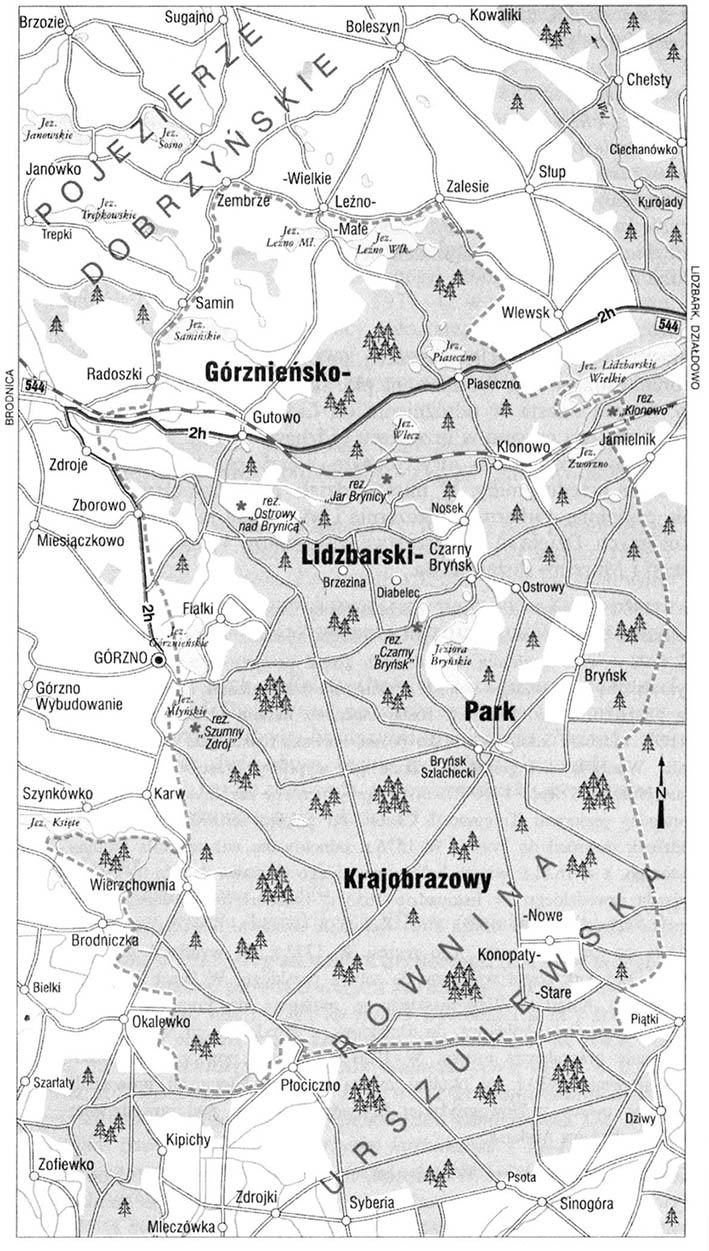Nearby, there are two landscape parks with special landscape and natural values.
 Górzno-Lidzbark Landscape Park
Górzno-Lidzbark Landscape Park
The Górzno-Lidzbark Landscape Park established in 1990 r. in the provinces of Ciechanów and Toruń, on the surface 18966 ha (31173 ha with lagging) in order to preserve the landscape and nature of the Chelmno-Dobrzyń Lake District shaped by the glacier and post-glacial processes. All the classic geomorphological forms for the postglacial areas are present here: hills, moraine hills and uplands, kemy, drumlins, ozy, outwash plains, sub-glacial gutters, river valleys and melting depressions. The area is extremely diverse in terms of landscape. The Górzanka gutter and the gutter are particularly attractive, depression and valley of Hrynica. The park has approx. 55 lakes, mainly gutter, with a total area 443 ha. Ok. 70% the terrain is forests, and the dominant tree is pine. There are approx. 900 vascular plant species. A number of rare and protected plants grow here, np. the slipper and the chrysanthemum. The park is also characterized by the richness of the animal world, especially the birdlife, including aquatic and predatory species. In the area of the landscape park was created 5 nature reserves: "Klonowo" (created in 1958 r. on the surface 30,85 ha in order to protect a mixed forest with pine and English oak), "Spring of Hrynica" (created in 1955 r. on the surface 29,47 ha in order to protect the broadleaved forest, a riparian and alder forest and a fragment of mixed coniferous forest growing on the bottom and slope of the ravine of the Hrynica River) and described later (str. 180): "Ostrowy nad Brynica", "Czarny Bryńsk" and "Szumny Zdrój im. K. Sulisławski ". Among the natural monuments, the "Dąb Rzeczypospolitej", growing near the Brynica River, with a trunk circumference, stands out 592 cm and height 32 m. In order to popularize the values of the park, two ecological education centers were established there: "Wilga" in Górzno and "Ekoczar" in Czarny Bryńsk.
Welski Landscape Park established in December 1995 r. on the surface 24 000 ha (along with the lagging), to protect the Wel river valley and adjacent areas. The Wel river has a very diversified course: meanders, flows through 6 lakes and is one of the few, the shape of which is natural. At first it flows lazily through wide plains, after Lidzbark, near the village of Chechły, turn into a rushing mountain river. The varied topography is the result of glacier activity. In the park there is 13 lakes. A relatively small part of it is covered with forest with dominant pine trees. It occurs in the park 29 protected plant species i 86 rare plant species. Among those found here 8 relict plant species occur, among others: low birch, knows fate blue clay and arnica. Among 20 monuments of nature the most interesting is probably the common juniper in the form of a tree, high 8,5 m and the circumference of the trunk 76 cm. The communities of aquatic plants are extremely interesting, riverside and peat bogs. There are, among others,. round-leaved sundew, common swamp, crest pennant, fine swimmer and the smallest porcupine. The avifauna is very varied among animals. I live here 209 bird species and up 183 is subject to species protection. Living here 39 species of mammals 16 are protected species, m.in. eastern hedgehog, killer whales of small rivers (from the shrew family, venomous species) i 7 bat species. Moreover, it occurs here 5 reptile species, 13 amphibians and 31 fish. In the park there are 3 nature reserves: "Czaplinieć Werski" (created in 1982 r. on the surface 14,59 ha, near the village of Wery – a forest fragment where the gray heron Ardea cinerea nestles), "Ostrów Tarczyński" (created in 1993 r. on the surface 108,11 ha between the lakes Grady and Tarczyński – with a unique landscape and flora; bird refuge) i "Bagno Koziana" (created in 1982 r. on the surface 54,85 ha in the west. parts of Lake Jeleń – refuge of wetland birds). The creation of further ones is planned 6 nature reserves in the WPK.
